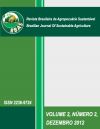GROWTH AND NUTRITIVE VALUE OF ELEPHANT GRASS SUBJECTED TO ORGANIC AND MINERAL FERTILIZER
DOI:
https://doi.org/10.21206/rbas.v2i2.175Abstract
The objective of this experiment was to evaluate the growth of elephant grass in two situations: cultivated in increasing amounts of nitrogen (1) and cultivated with three types of organic fertilizers (goat, cattle and pork manure) (2), being evaluated the forage biomass production, the morphological and physiological characteristics and the nutritional value of elephant grass at conditions of low Parnaíba. For the two situations a completely randomized design with four treatments and three replications were used. The treatments with chemical fertilizer (1) consisted of 0, 100, 200 and 300 kg/ha of nitrogen (N) as urea and the treatments with organic fertilizer (2) were: control (no fertilizer), and cattle, goats and pigs manure. It was observed for the experiment with chemical fertilizer differences between treatments for the production of green biomass, in which the treatment with 300 kg/ha of N showed the highest value (6.68 kg/m²). For dry matter (DM), there was difference in the treatments control and 200 kg/ha of N with others, and the treatment 100 kg/ha of N presented the highest value (20.88%). In relation to crude protein (CP) it was observed difference for all treatments, in which 300 kg/ha of N treatment showed the highest value (12.78%). The digestibility of DM had a higher value in the treatment with 300 kg/ha of N (53.69%), differentiating from others. It was observed for the experiment with organic fertilizers differences between treatments for the production of green biomass, in which the treatment with pig manure presented the highest value (9.68 kg/m²). In relation to crude protein (CP) there was only a difference between control and other treatments, as well as for gross energy. The digestibility of dry matter differed among treatments, with a lower value for the swine manure (46.93%). For both situations, there was no difference between treatments for the morphogenesis. The organic and chemical fertilizer increases the green biomass and crude protein and does not interfere with morphogenesis of elephant grass.Downloads
Downloads
Published
2012-12-01
How to Cite
Henrique Nunes Parente, Jefferson Ribeiro Bandeira, Rosane Cláudia Rodrigues, Michelle de Oliveira Maia Parente, Xerxes Moraes Tosta, & Osias Rodrigues da Silva Júnior. (2012). GROWTH AND NUTRITIVE VALUE OF ELEPHANT GRASS SUBJECTED TO ORGANIC AND MINERAL FERTILIZER. Brazilian Journal of Sustainable Agriculture, 2(2). https://doi.org/10.21206/rbas.v2i2.175
Issue
Section
Artigos
License
1. Proposta de Política para Periódicos de Acesso Livre
Autores que publicam nesta revista concordam com os seguintes termos:
Autores mantém os direitos autorais e concedem à revista o direito de primeira publicação, com o trabalho simultaneamente licenciado sob a Licença Creative Commons Attribution que permite o compartilhamento do trabalho com reconhecimento da autoria e publicação inicial nesta revista.












